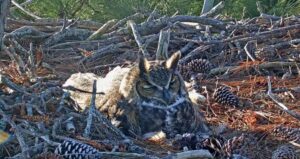Live Great Horned Owl Cams
Ellis GHO Nest Cam
active March-June
Wildflower Great Horned Owl Cam
active Feb-May
SPO Signup
Get Updates, Discover New Cams, It’s Free!
Latest Posts:
- PIP Spotted, Hatch In Progress! – Wildflower Great Horned Owl Live CamHNF – A PIP was spotted early this morning after Athena left for a short break. From the view a pip can be seen at the top of the egg and also on the back side it looks like maybe a much larger crack. We could see a hatch today! Stay tuned, don’t forget to…
- Video – First Of Two Eggs Hatches – Wildflower Great Horned OwlsHNF – The first egg hatched this morning. In this video you will see the owlet just after it hatches. The 2nd egg was laid 3 days after the first. So we should see a hatch for that egg by the end of the week. Stay tuned, don’t forget to sign up for our email updates if…
- Video – 2ND Egg Laid! – Wildflower Great Horned Owl CamHNF – 2nd egg laid video The Great Horned Owls at the Lady Bird Johnson Wildflower Center have laid their second egg of the 2025 breeding season. Athena laid the first egg on March 6 and the second on March 9. It is likely their clutch is complete, as Athena has laid two eggs each…
- Ellis Owl Nest is Active!Lin11 – Feb.25, 2025 a GHO arrived at nest 18:09. Stayed several minutes renovating nest bowl and exchanging communications with nearby mate. Not sure if this is a returning or new pair. Last years hatch came at the beginning of May. With the warmer weather we might see nesting a little earlier. Watch live:
- Ellis Owl Cam Nest UpdateHNF – Both eggs hatched! May 6th HATCH: 05:05:2024 ConfirmedMay 9th: HATCH: 09:05:2024 Confirmed Watch live:https://sportsmansparadiseonline.com/ellis-owl-cam/
Description
Size: 25 inches (64 cm)
Weight: 2-3 1/4 lbs (906-1472g)
Migration: Partial Migrant
Habitat: Most forst types, grassland, shrubland, and rocky areas with steep gorges
Population: Common
Interesting Fact:
Great Horned Owls are the largest of the eared owls.
Where Great Horned Owls live:
They inhabit a range of habitats including deciduous and mixed woodland, open country, and occasionally suburban parkland.
What Great Horned Owls eat:
They feed on rabbits, lizards, frogs, and birds. They are capable of taking birds up to the size of a crow.
What is a pip?
A pip hole is a tiny hole that the eaglet inside the egg makes with its “egg tooth” (a sharp little point at the end of its beek) in the outside shell when it first starts to hatch.
Great Horned Owl Ear Tufts:
Several owls, including the Great Horned Owl, have prominent ear tufts or “horns”, as they are also called. The function of these tufts remains disputed. Some argue that they aid in daytime camouflage, breaking up the shape and helping it blend with its perch. Others believe that the tufts are used for behavioral signaling and species recognition. What appears clear, however, is that they have no role in hearing.
Great Horned Owl

When Great Horned Owls nest:
Great Horned Owls are one of the earliest to begin breeding, they often start to lay eggs in late January, when there is still snow on the ground.
About Great Horned Owls
This large, mainly nocturnal, owl has large erect ear tufts, and its gray – mostly brown plumage is mottled above and barred underneath, helping it roost virtually undetected during daylight hours. It’s mostly commonly seen with rust-brown facial disks and a white chin and throat. Occuring throughout North and South America, from the most northern treeline and south to Chile, the Great Horned Owl occupies the widest habitat range of any owl in the world. This is because it takes a wide vareity of prey and will use virtually any nesting site, including rock faces and old buildings that offer sufficient cover.
What They Look Like:
They can vary greatly in color from almost white (in the far north), to brown and grays farther south. They are heavily mottled and streaked birds with a distinctive white throat. The ear tufts are prominent as the large yellow eyes.
Where Great Horned Owls nest:
The nest will often be on a cliff ledge or occasionally on the ground. They are also recorded using old heron and hawk nests. They will lay 2 or 3 white eggs.

